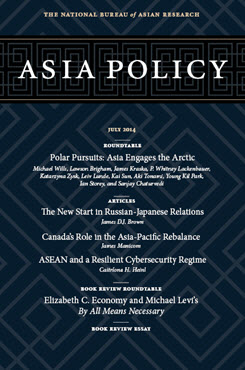The Arctic Novice
Singapore and the High North
This essay is part of the roundtable “Polar Pursuits: Asia Engages the Arctic.”
Singapore’s decision in 2011 to apply for observer status to the Arctic Council took many people by surprise. Why would a densely populated city-state lying on the equator invest diplomatic time and effort into joining a forum composed of circumpolar states and indigenous Arctic peoples? The answer is threefold: a long-standing, proactive involvement in international forums that address global governance issues; a desire to better understand and respond to climate change; and an ambition to capture economic opportunities as well as prepare for potential commercial challenges.
Singapore is a global city that has established itself as an international financial, shipping, and aviation hub. The downside to being the poster child of globalization, however, is that developments in one part of the world can have a negative impact on the country’s own economic fortunes, as was illustrated by the 2008 global financial crisis. Singapore has thus adopted a proactive approach to joining global governance forums and institutions so that it can help shape positive outcomes in areas that affect the city-state’s core interests, such as ocean management, international shipping, and maritime legal regimes.
Singapore is also concerned about the impact of climate change. As a low-lying island less than fifteen meters above sea level, it is acutely vulnerable to rising sea levels, caused in part by the melting of glaciers in the Arctic. In addition to the prospect of coastal erosion and land loss, global warming poses other threats to Singapore such as water scarcity, flooding, and the spread of tropical diseases. In order to update its assumptions about climate change and ensure that appropriate protective measures are implemented, [1] Singapore wants to better understand environmental changes in the Arctic, where temperatures are rising twice as fast as in other parts of the world. Singapore also has economic interests in the Arctic. Unlike the energy-hungry giants of Northeast Asia—China, Japan, and South Korea, which also gained observer status to the Arctic Council last year—Singapore is less interested in consuming the region’s natural resources than in marketing the cutting-edge maritime technologies that will be required to develop them, especially drilling platforms. But even as rapid sea ice retreat makes Arctic resources more accessible, it also raises the prospect of higher volumes of traffic on trade routes through the Arctic Ocean, which provide considerably shorter sailing times between Europe and Asia. It has been suggested that, in the long-term, one of these passages, the Northern Sea Route (NSR), could take away some of Singapore’s lucrative shipping business. While Singapore is not alarmed by the prospect of increased traffic on the NSR, it remains vigilant, as shipping is its bread and butter.
This essay will examine Singapore’s role and interests in Arctic affairs in three areas: the country’s successful bid for observer status to the Arctic Council and the expected contributions it can make to Arctic governance, the potential commercial opportunities for Singaporean companies, and the possibility that the NSR will pose a challenge to the city-state’s status as a global maritime transshipment hub.
Singapore and the Arctic Council
Singapore evinced a serious interest in Arctic affairs only in the late 2000s, when accelerated ice melt brought into sharp relief the serious impact of climate change, including the prospect of longer navigational seasons on the NSR. In May 2011 the opportunity arose for Singapore to play a modest role in Arctic governance when the Arctic Council, the region’s principal intergovernmental forum, issued criteria for observer status and outlined the roles observers would play. [2] Once accredited, observers are invited to attend meetings and engage with the six working groups, and they may also propose projects through an Arctic state or permanent participant…
Endnotes
[1] For example, in 2011 the height of reclamation projects in Singapore was raised from 1.25 meters to 2.35 meters to take account of rising sea levels. “S’pore Takes First Steps on Plan to Protect Its Coast,” Straits Times, June 19, 2013.
[2] Arctic Council, “The Nuuk Declaration,” May 12, 2011, available at http://www.arctic-council.org/index.php/en/document-archive/category/5-declarations. The seven criteria are “to accept and support the objectives of the Arctic Council; recognize the Arctic states’ sovereignty and jurisdiction in the Arctic; recognize that existing legal frameworks, notably the Law of the Sea, apply to the management of the Arctic Ocean; respect the values, rights, and cultures of Arctic indigenous peoples; demonstrate a willingness and financial ability to contribute to the work of the permanent participant organizations that represent the indigenous populations of the Arctic; demonstrate expertise relevant to the Arctic Council; and show a willingness to bring Arctic issues to global decision making bodies.” See Arctic Council, “Observers,” http://www.arctic-council.org/index.php/en/about-us/arctic-council/observers.
About Asia Policy
Asia Policy is a peer-reviewed scholarly journal presenting policy-relevant academic research on the Asia-Pacific that draws clear and concise conclusions useful to today’s policymakers. Asia Policy is published quarterly in January, April, July, and October and accepts submissions on a rolling basis. Learn more


